Papers by Mohamed Barakat
arXiv: Algebraic Geometry, 2014
The purpose of this paper is to develop an efficient computational model for Abelian categories o... more The purpose of this paper is to develop an efficient computational model for Abelian categories of coherent sheaves over certain classes of varieties. These categories are naturally described as Serre quotient categories. Hence, our approach relies on describing general Serre quotient categories in a constructive way which leads to an efficient computer implementation.
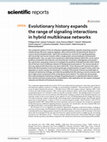
Scientific Reports
Two-component systems (TCSs) are ubiquitous signaling pathways, typically comprising a sensory hi... more Two-component systems (TCSs) are ubiquitous signaling pathways, typically comprising a sensory histidine kinase (HK) and a response regulator, which communicate via intermolecular kinase-to-receiver domain phosphotransfer. Hybrid HKs constitute non-canonical TCS signaling pathways, with transmitter and receiver domains within a single protein communicating via intramolecular phosphotransfer. Here, we report how evolutionary relationships between hybrid HKs can be used as predictors of potential intermolecular and intramolecular interactions (‘phylogenetic promiscuity’). We used domain-swap genes chimeras to investigate the specificity of phosphotransfer within hybrid HKs of the GacS–GacA multikinase network of Pseudomonas brassicacearum. The receiver domain of GacS was replaced with those from nine donor hybrid HKs. Three chimeras with receivers from other hybrid HKs demonstrated correct functioning through complementation of a gacS mutant, which was dependent on strains having a fu...

Strong anion exchange resin (Spectra/Gel IE 1x8) has been investigated as adsorbent for the effic... more Strong anion exchange resin (Spectra/Gel IE 1x8) has been investigated as adsorbent for the efficient removal of Cr(VI) ions from synthetic wastewater solutions. Batch experiments were conducted with initial Cr(VI) ions concentration ranging from 25-300 mg/L. Different parameters influencing Cr(VI) adsorption process such as; solution pH, Cr(VI) and adsorbent concentration and contact time were investigated. Results obtained revealed that Cr(VI) was successfully retained by the resin. Equilibrium was established within 30 minutes for initial Cr(VI) concentration up to100 mg/L. The equilibrium data for adsorption of Cr(VI) was fitted with both Langmuir and Freundlich isotherms, however, Langmuir isotherm model was found to be more suitable for the Cr(VI) adsorption and maximum adsorption capacity of the Cr(VI) was found to be 173.8 mg/g. The adsorption process followed second order kinetics. The resin was regenerated by using 4M NaOH as an eluent with Cr(VI) adsorption efficiency hig...
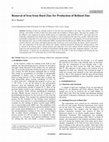
The Open Mineral Processing Journal
Refining of hard zinc through removal of iron has been investigated in this study. Zinc powder, a... more Refining of hard zinc through removal of iron has been investigated in this study. Zinc powder, aluminum turnings, and mixture of both of them have been tested and evaluated as refining agents. The hard zinc samples with the additives were charged in an electric muffle furnace at a temperature range from 600 to 900°C. Iron oxide and its intermetallic compounds of Fe with Zn have been formed as a slag of refining in the sink of the crucible, while that of the intermetallic compounds of Fe with Al have been floated on the melt bath surface and skimmed. Several characterization and analytical tools, such as X-Ray Diffraction (XRD), Scanning Electron Microscopy (SEM), Energy Dispersive X-ray Analysis (EDAX), and Atomic Absorption Spectroscopy (AAS) were used to investigate the phases, surface microstructure, and composition of the hard and refined zinc samples. Different parameters affecting the refining process such as amount of the refining agents, refining duration and temperature have been studied. Results obtained revealed that removal of iron from hard zinc was achieved with different refining agents in the order; aluminum turnings > zinc dust> Al/Zn mixture. A refined zinc was obtained by adding 0.4 wt % Al at 700 °C after 2h of refining with lowering the iron concentration from 3.2 % in the hard zinc to 0.5% in the refined product.

Nature Microbiology
Toxoplasma gondii has a complex life cycle that is typified by asexual development that takes pla... more Toxoplasma gondii has a complex life cycle that is typified by asexual development that takes place in vertebrates, and sexual reproduction, which occurs exclusively in felids and is therefore less studied. The developmental transitions rely on changes in the patterns of gene expression, and recent studies have assigned roles for chromatin shapers, including histone modifications, in establishing specific epigenetic programs for each given stage. Here, we identified the T. gondii microrchidia (MORC) protein as an upstream transcriptional repressor of sexual commitment. MORC, in a complex with Apetala 2 (AP2) transcription factors, was shown to recruit the histone deacetylase HDAC3, thereby impeding the accessibility of chromatin at the genes that are exclusively expressed during sexual stages. We found that MORC-depleted cells underwent marked transcriptional changes, resulting in the expression of a specific repertoire of genes, and revealing a shift from asexual proliferation to sexual differentiation. MORC acts as a master regulator that directs the hierarchical expression of secondary AP2 transcription factors, and these transcription factors potentially contribute to the unidirectionality of the life cycle. Thus, MORC plays a cardinal role in the T. gondii life cycle, and its conditional depletion offers a method to study the sexual development of the parasite in vitro, and is proposed as an alternative to the requirement of T. gondii infections in cats. The microrchidia (MORC) protein from Toxoplasma gondii is a transcriptional repressor that regulates parasite development and sexual commitment, and its conditional depletion paves the way to develop improved in vitro systems to investigate parasite sexual development.
American Journal of Gastroenterology

Acta gastro-enterologica Belgica
Drug induced liver injury (DILI) is an infl ammation of the liver and is the most common cause of... more Drug induced liver injury (DILI) is an infl ammation of the liver and is the most common cause of acute liver failure in the United States. Herein, we report a case of DILI caused by a preservative in an epinephrine autoinjector. A 35 year old man with no past medical history presented to the hospital for yellowish discoloration of the eyes. History revealed the use of an epinephrine autoinjector to treat an itchy erythematous rash three weeks prior to presentation and two days prior to the onset of jaundice and pruritus. Th ere was no use of illicit drugs, medication or herbal preparations. Physical exam revealed jaundice and a hyperpigmented patch on the back. Laboratory tests revealed ALT 700 U/L, AST 394 U/L, ALP 636 U/L, GGT 361 U/L, total bilirubin 26.7 mg/dL and conjugated bilirubin 16.0 mg/dL. Hepatitis viral serologies were negative. Liver biopsy showed severe panlobular acute cholestatic hepatitis, suggestive of DILI. All laboratory abnormalities normalized within six months. An epinephrine autoinjector is a medical device used to inject a measured dose of epinephrine by means of autoinjector technology. In addition to a pre-determined dose of epinephrine, autoinjectors contain a preservative such as sodium metabisulphite to prevent browning which can lead to a decrease in the eff ectiveness of epinephrine. Sulfi tes are well known to cause allergic reactions in those with sulfi te allergies[1]; incidence has increased with the widespread use of sulfi tes. In addition to their antioxidant eff ects, sulfi tes may oxidize into sulfi te radicals (SO3-), which can lead to multi-organ harm. It has been shown that sulfi te radicals initiate lipid peroxidation and infl ammation in rat liver and kidney when ingested[3]. Th is has been demonstrated through the measurement of malondialdehyde (MDA) levels which signifi cantly increased in mice that were exposed to sodium metabisulfi te. It has also been shown that sulfi tes can induce an infl ammatory response through the omega 6 infl ammatory pathway in rat liver[4]. In our patient, DILI followed the inappropriate use of an epinephrine autoinjector which suggests that his injury was caused by sodium metabisulphite. Epinephrine is a naturally occurring substance in the human body and is unlikely to be the cause of DILI. Th is case illustrates the importance of detailed history to determine the cause of DILI and the relevance of exploring potential adverse eff ects of preservatives and excipients used in medical preparations.
ACG case reports journal, 2018
Pyogenic liver abscess (PLA) is the result of portal vein pyemia, which usually originates from t... more Pyogenic liver abscess (PLA) is the result of portal vein pyemia, which usually originates from the hepatobiliary system or the gastrointestinal tract. Gram-negative organisms are the most common causative pathogens in PLA. is an anaerobic gram-positive, low-virulence organism that most commonly affects neutropenic patients with hematological malignancy and has not been reported to cause PLA. We report an unusual presentation of a infection as a PLA in a previously healthy, immunocompetent patient with no identifiable source of portal pyemia.
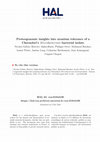
Journal of proteomics, Jan 6, 2017
Microbacterium oleivorans A9 is a uranium-tolerant actinobacteria isolated from the trench T22 lo... more Microbacterium oleivorans A9 is a uranium-tolerant actinobacteria isolated from the trench T22 located near the Chernobyl nuclear power plant. This site is contaminated with different radionuclides including uranium. To observe the molecular changes at the proteome level occurring in this strain upon uranyl exposure and understand molecular mechanisms explaining its uranium tolerance, we established its draft genome and used this raw information to perform an in-depth proteogenomics study. High-throughput proteomics were performed on cells exposed or not to 10μM uranyl nitrate sampled at three previously identified phases of uranyl tolerance. We experimentally detected and annotated 1532 proteins and highlighted a total of 591 proteins for which abundances were significantly differing between conditions. Notably, proteins involved in phosphate and iron metabolisms show high dynamics. A large ratio of proteins more abundant upon uranyl stress, are distant from functionally-annotated ...

Acta oncologica (Stockholm, Sweden), Jan 14, 2017
Early death after a treatment can be seen as a therapeutic failure. Accurate prediction of patien... more Early death after a treatment can be seen as a therapeutic failure. Accurate prediction of patients at risk for early mortality is crucial to avoid unnecessary harm and reducing costs. The goal of our work is two-fold: first, to evaluate the performance of a previously published model for early death in our cohorts. Second, to develop a prognostic model for early death prediction following radiotherapy. Patients with NSCLC treated with chemoradiotherapy or radiotherapy alone were included in this study. Four different cohorts from different countries were available for this work (N = 1540). The previous model used age, gender, performance status, tumor stage, income deprivation, no previous treatment given (yes/no) and body mass index to make predictions. A random forest model was developed by learning on the Maastro cohort (N = 698). The new model used performance status, age, gender, T and N stage, total tumor volume (cc), total tumor dose (Gy) and chemotherapy timing (none, seque...

Journal of environmental management, Jan 2, 2017
Biogas production using waste activated sludge (WAS) is one of the most demanding technologies fo... more Biogas production using waste activated sludge (WAS) is one of the most demanding technologies for sludge treatment and generating energy in sustainable manner. The present study deals with the photocatalytic pretreatment of WAS using ZnO-ZnS@polyaniline (ZnO-ZnS@PANI) nanocomposite as means for increasing its degradability for improved biogas production by anaerobic digestion (AD). Photocatalysis accelerated the hydrolysis of WAS and increased the sCOD by 6.7 folds after 6 h and transform tCOD into bioavailable sCOD. After the AD of WAS, a removal of organic matter (60.6%) and tCOD (69.3%) was achieved in photocatalytic pretreated sludge. The biogas production was 1.6 folds higher in photocatalytic sludge with accumulative biogas up to 1645.1 ml L(-1)vs after 45 days compared with the raw sludge (1022.4 ml L(-1)VS). Moreover, the photocatalysis decrease the onset of methanogenesis from 25 to 12 days while achieve the maximum conversion rate of reducing sugars into organic acids at ...
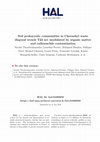
FEMS microbiology ecology, Aug 22, 2017
After the Chernobyl nuclear power plant accident in 1986, contaminated soils, vegetation from the... more After the Chernobyl nuclear power plant accident in 1986, contaminated soils, vegetation from the Red Forest, and other radioactive debris were buried within trenches. In this area, trench T22 has long been a pilot site for the study of radionuclide migration in soil. Here, we used 454 pyrosequencing of 16S rRNA genes to obtain a comprehensive view of the bacterial and archaeal diversity in soils collected inside and in the vicinity of the trench T22 and to investigate the impact of radioactive waste disposal on prokaryotic communities. A remarkably high abundance of Chloroflexi and AD3 was detected in all soil samples from this area. Our statistical analysis revealed profound changes in community composition at the phylum and OTUs levels and higher diversity in the trench soils as compared to the outside. Our results demonstrate that the total absorbed dose rate by cell and, to a lesser extent the organic matter content of the trench, are the principal variables influencing prokary...
Journal of Advanced Studies in Topology, 2016
In this work, we introduce a new concept of generalized weak partial metric space (Gw p-metric sp... more In this work, we introduce a new concept of generalized weak partial metric space (Gw p-metric space) which is a unification between generalized partial metric space (Gp-metric)and weak partial metric spaces. Also,wedemonstratesomefixedpointtheorems in a complete Gw p-metric space. An illustrative example is offered to uphold our results.

Colloids and Interface Science Communications, 2015
ABSTRACT Zero valent silver nanoparticle deposited TiO2 composite (Ag/TiO2) has been prepared and... more ABSTRACT Zero valent silver nanoparticle deposited TiO2 composite (Ag/TiO2) has been prepared and characterized by SEM, TEM, XPS and FTIR techniques. The photocatalytic property of Ag/TiO2 for the degradation of methylene blue (MB) was investigated under the ultraviolet-C light irradiation. The effect of various operation parameters such as solution pH, irradiation time, initial MB concentration and catalyst dose was also studied. The results indicated that an increase in solution pH boosted the photocatalytic degradation of MB by Ag/TiO2 reaching a maximum at pH 9.0. The degradation of MB decreased from 96.66% to 45.76% with the rise in startup MB concentration from 3 to 13 mg/L. An enhanced degradation of MB was noticed with the increment in the amount of composite from 0.025 g to 0.1 g and afterwards an increase in catalyst mass resulted in reduction in the degradation of MB. Moreover, Ni(II) amelioration in MB solution also showed an adverse effect on Ag/TiO2 activity.

Science of The Total Environment, 2016
The bloom-containing water bodies may have an impact due to cyanotoxins production on other micro... more The bloom-containing water bodies may have an impact due to cyanotoxins production on other microorganisms and aquatic plants. Where such water is being used for crops irrigation, the presence of cyanotoxins may also have a toxic impact on terrestrial plants and their rhizosphere microbiota. For that purpose, PCR-based 454 pyrosequencing was applied to phylogenetically characterize the bacterial community of Medicago sativa rhizosphere in response to cyanotoxins extract. This analysis revealed a wide diversity at species level, which decreased from unplanted soil to root tissues indicating that only some populations were able to compete for nutrients and niches in this selective habitat. Gemmatimonas, Actinobacteria, Deltaproteobacteria and Opitutae mainly inhabited the bulk soil, whereas, the root-adhering soil and the root tissues were inhabited by Gammaproteobacteria and Alphaproteobacteria. The proportion of these populations fluctuated in response to cyanotoxins extract exposure. Betaproteobacteria proportion increased in the three studied compartments, whereas Gammaproteobacteria proportion decreased except in the bulk soil. This study revealed the potential toxicity of cyanotoxins extract towards Actinobacteria, Gemmatimonas, Deltaproteobacteria, and Gammaproteobacteria, however Clostridia, Opitutae and bacteria related with Betaproteobacteria, were stimulated denoting their tolerance. Altogether, these data indicate that crop irrigation using cyanotoxins containing water might alter the rhizosphere functioning.
Renewable Energy, 2001
A zero emission process was established by treatment of a spent liquor resulting from frequent pi... more A zero emission process was established by treatment of a spent liquor resulting from frequent pickling of copper alloy rods in sulfuric acid. The spent liquor contains 35 g l−1 copper, 25 g l−1 zinc, 1.1 g l−1 chromium, 45 g l−1 sulfuric acid, and 135 g l−1 total sulfate. These pollutant materials, if discharged directly into water bodies, pose
The purpose of this paper is to develop an efficient computational model for Abelian categories o... more The purpose of this paper is to develop an efficient computational model for Abelian categories of coherent sheaves over certain classes of varieties. These categories are naturally described as Serre quotient categories. Hence, our approach relies on describing general Serre quotient categories in a constructive way which leads to an efficient computer implementation.
RSC Advances, 2014
This work described the synthesis and characterization of a starch–AlOOH–FeS2 nanocomposite for t... more This work described the synthesis and characterization of a starch–AlOOH–FeS2 nanocomposite for the adsorption of congo red (CR) dye from aqueous solution.
The Egyptian Journal of Radiology and Nuclear Medicine, 2014
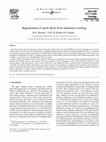
Separation and Purification Technology, 2005
Spent liquor from washing of aluminum section materials after etching with caustic soda (NaOH) ha... more Spent liquor from washing of aluminum section materials after etching with caustic soda (NaOH) has been treated. Aluminum was removed from the liquor and caustic soda was regenerated by: (a) adding precipitating agents to hydrolyze sodium aluminate (Na 2 AlO 2), (b) separating the aluminum precipitate, and (c) concentrating free NaOH in the resulting solution which is reused in the etching process. Four systems were investigated: hydrated lime {Ca(OH) 2 }, hydrogen peroxide (H 2 O 2), H 2 O 2 /Ca(OH) 2 mixture, and dry lime (CaO). Different parameters, such as additives concentration, time and temperature were investigated. Results obtained revealed that CaO was more efficient in the removal of aluminum from the spent liquor with higher hydrolyzing rate of Na 2 AlO 2 than Ca(OH) 2 , H 2 O 2 , or their mixture. The removal efficiency value of aluminum was 96.1% with 100 g/L of CaO at 60 • C after 30 min treatment, while the efficiency values were 83.2 and 90.1% with Ca(OH) 2 and H 2 O 2 , respectively after 2 h treatment. The presence of Ca(OH) 2 in the H 2 O 2 /Ca(OH) 2 mixture has no great effect on the Al removing efficiency comparing to that using H 2 O 2 alone, however, it greatly facilitated the separation of the Al precipitate from the solution as calcium aluminate hydrate. Caustic soda concentration of 102 g/L, which is applicable for reusing as etching solution, was obtained by heating the solution for 1 h at 95 • C.
Uploads
Papers by Mohamed Barakat